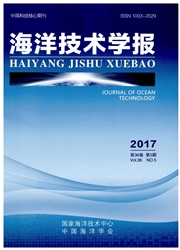

 中文摘要:
中文摘要:
基于2011年5月渤海湾调查数据,从大面结果来看,海河入海口至套儿河河口区域近岸表层和底层叶绿素浓度较高,渤海湾中部区域水体叶绿素浓度较低,最低值区域出现在渤海湾湾口的断面附近;表层叶绿素浓度和温度、盐度、磷酸盐具有较好的相关关系(R2>0.66),利用SPSS进行相关性分析,可以看出温度,盐度,总氮,磷酸盐和硅酸盐均对浮游植物的生长有重要影响,但其中最主要因素是温度,与叶绿素浓度为正相关关系,其次是磷酸盐,与叶绿素浓度为负相关关系;通过典型站位和连续站的分析可以看出,当光合有效辐射增加时,温盐密度垂直变化增大,叶绿素浓度垂直变化也增大。
 英文摘要:
英文摘要:
Based on all the stations' survey data in the Bohai Bay in May 2011, the chlorophyll concentration is higher on the inshore surface and bottom of the area from the Haihe River estuary to Taoer River estuary, and is lower in the central region of the Bohai Bay, with the lowest chlorophyll concentration zone appearing near the section of the Bohai Bay mouth. Good correlation(R2〉0.66) exists among surface chlorophyll concentration and temperature, salinity and phosphates. The correlation analysis using SPSS shows that temperature, salinity, total nitrogen, phosphates and silicates have a significant impact on phytoplankton growth. Among these factors, the most important factor is temperature which has positive correlation with chlorophyll concentration; followed by phosphates which have negative correlation with chlorophyll concentration. The analysis based on typical stations and continuous stations indicates that the vertical variations of chlorophyll concentration, temperature, salinity and density increase when the photosynthetically active radiation(PAR) increases.
 同期刊论文项目
同期刊论文项目
 同项目期刊论文
同项目期刊论文
 期刊信息
期刊信息
